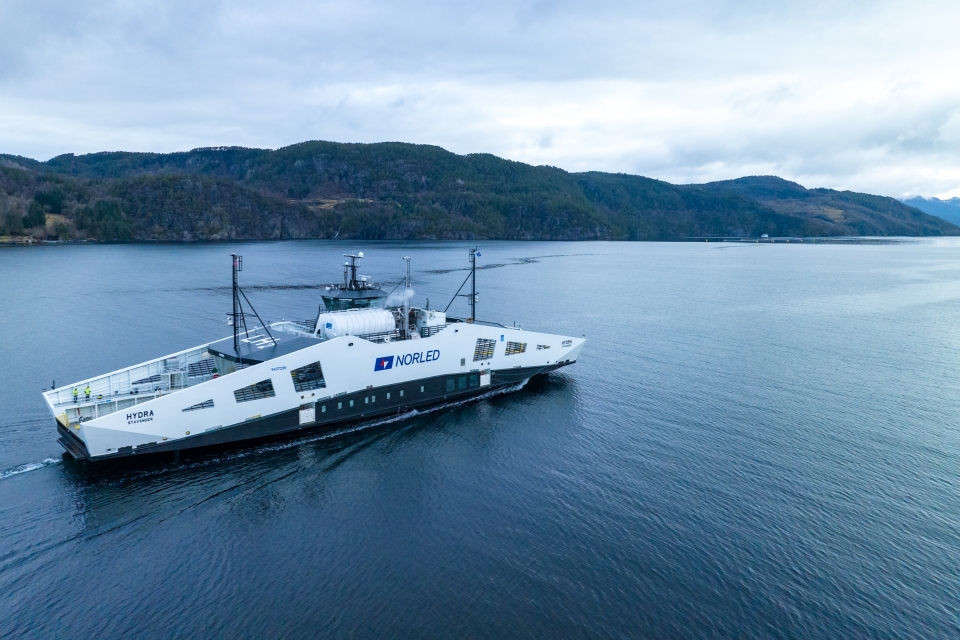On 31 March, the MF Hydra was put into operation running on zero-emission liquid hydrogen. In addition to the major technology development, a great deal of work has been done to develop rules and regulations to enable Norwegian passenger ships to run on hydrogen.
In the year 2000, the MF Glutra became the first car ferry to run off liquified natural gas (LNG). The use of LNG reduces greenhouse gas emissions, as compared to traditional diesel operation.
Eleven years ago, the Norwegian Public Roads Administration (NPRA) issued a tender which resulted in the MF Ampere, the world’s first electrical battery-operated ferry with propeller drive. This led to an electric ferry revolution in Norway. Today, the country has around seventy electric ferries in operation.
The use of liquid hydrogen as fuel was a requirement in the tender specification for the MF Hydra. Anders Sæternes of NPRA Ferry Management: ‘We have a tradition of using our role as a major purchaser to accelerate development towards the goals set for the transport sector. It is important for us to use our purchasing power for transition. Zero-emission vessels play an important part in this.’
He adds: ‘Therefore, by putting the world’s first hydrogen ferry into operation, we now take yet another substantial leap towards the goal of zero emissions – in regards to ferries as well as the general maritime industry – both in Norway and internationally.’
World’s first ship sailing on liquid hydrogen
The MF Hydra is the world’s first ship sailing on liquid hydrogen. Since the turn of the year, Norled has been carrying out system tests at the quay in Hjelmeland. In recent weeks, they have been running sea trials and received the final approvals from the Norwegian Maritime Authority (NMA).
‘There are only two parties in the world that use liquid hydrogen as a fuel. These are Norled with the MF Hydra, and then the space industry using it as fuel for launches. This says something about the giant technology leap now taken for the maritime industry. After a lot of development and testing, we are now looking forward to welcoming passengers on board for a zero-emission journey between Hjelmeland and Nesvik,’ states Erlend Hovland, Chief Technology Officer of Norled.
Also read: EU awards funding for two hydrogen powered vessels
Paving the way
When the work on the MF Hydra started, both technology and regulations from classification societies and the Norwegian Maritime Authority were inadequate. These are now in place.
Liquid hydrogen may be playing an important role in the green maritime transition. The pilot project in Hjelmeland is therefore very important for global shipping.
‘By putting the world’s first hydrogen ferry into operation on a Norwegian ferry connection, we are once again showing how purchasing power and good public-private partnerships can be used to develop new and groundbreaking technology. This is important if we are to achieve Norwegian and international targets for substantial emission cuts towards 2030 and 2050. When Norled once again dares to go first, it will be much easier for others to follow in the wake of the MF Hydra,’ says Ada Jakobsen, CEO of Maritime CleanTech.
Norled has been the leader of the project to develop the technology needed for the MF Hydra. Linde Engineering in Germany has supplied the hydrogen systems on board. Danish Ballard has developed the fuel cells that produce electricity from hydrogen.
Westcon in Ølensvåg has been responsible for equipping and completing the vessel together with system integrator Seam from Karmøy. Seam has also supplied the automation scope for the hydrogen system. Corvus Energy has supplied the batteries for the MF Hydra and the vessel has been approved by DNV.
Picture: MF Hydra with the white hydrogen tank visible. The steam is water steam (photo: Norled).
Also read: Corvus Energy to develop maritime fuel-cell systems with Toyota








